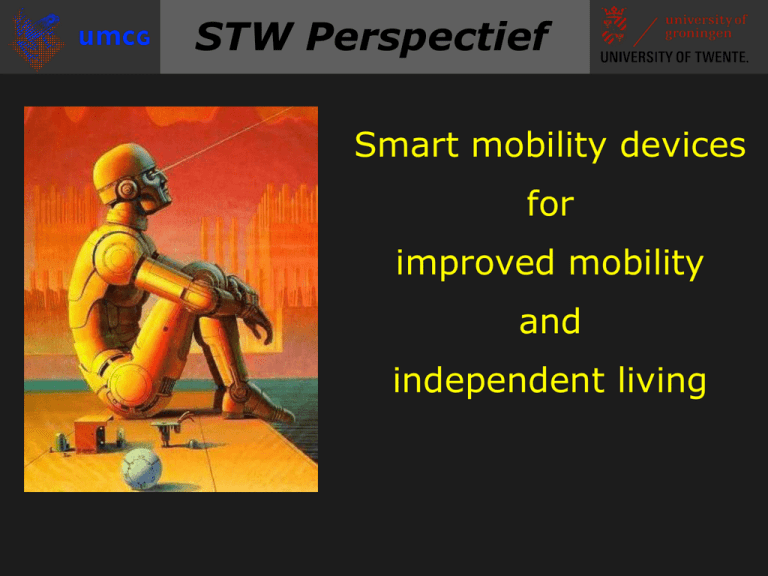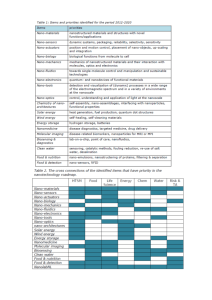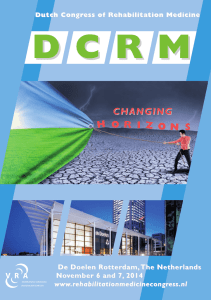Klik hier voor deze presentatie.
advertisement

STW Perspectief Smart mobility devices for improved mobility and independent living STW-Perspectief Doelstelling • Oplossen van innovatie-knelpunten • Ontwikkelen van nieuwe technologie • Multidisciplinaire aanpak • Samenwerking met gebruikers • Medefinanciering door private partijen • Valorisatie en ondernemerschap • Vernieuwende kennis tot toepassing brengen STW-Perspectief Schema • Fase A: programma-initiatief – 17 juni STW-website, match-making • Fase B: programma-ontwerp – 30 augustus Voorstel, 6 x A4 • Fase C: programmavoorstel – ? ? ? Uitgebreid voorstel met coherente set projecten STW-Perspectief Match-making • onderzoeksthema afbakenen • onderzoeksthema invullen • opbouw programma vaststellen • stakeholders uitnodigen • toekomstige onderzoeksgemeenschap structureren • deelnemers werven STW-Perspectief Eisen • Minimaal 3 universiteiten • Niet regionaal • Onderzoekers nemen deel aan max 1 voorstel • Ontwikkeling nieuwe technologie • Onderscheidend van andere netwerken • Aansluiting thema met strategisch beleid van uni’s STW-Perspectief Eisen • Innovatie-/utilisatiefocus en/of nieuwe multidisciplinaire samenwerking • Minimaal 5 bedrijven of gebruikers • Cofinanciering: 25% van > k€ 500 • Bijdrage in steunbrief melden • Looptijd max 6 jaar STW-Perspectief Programma-ontwerp • onderbouwing van de onderzoekslijnen • type en aantal projecten • schatting en onderbouwing financiële middelen • Budget 2 - 7,5 M€ SPRINT thema’s 1. Interactive training programs and devices to prevent falls 2. Interactive training programs and devices for rehabilitation at home 3. Smart prostheses and orthoses, patient-driven Research en Technologie • Control technologies, based on Discovery Learning • Sensor technologies for balance, motion, activation • Training technologies to improve balance • Rehabilitation technologies to restore walking • Interface technologies to implement serious gaming • Smart, self-learning algorithms for dynamic feedback • User interfaces for telemonitoring • Smart prostheses, orthoses, wheelchairs • Implementation in care and valorisation Projecten • Voorbeeld van omvang project: 2 promovendi à k€ 180 + bench fee = k€ 500 • Max 15 van deze projecten Deelnemers Universities • UMCG (including: Center for Rehabilitation, NeuroImaging Center, departments of Orthopaedics, Biomedical Engineering, Human Movement Sciences, Neurology, Medical Physiology, ENT • RUG (Institute for Mathematics and Informatics, Departments of Discrete Technology & Production Automation and Business & ICT. • UT (Departments of Biomechanical Engineering, Biomedical Signals & Systems, Design, Production and Management) Private research groups • Healthcare Innovation Forum • INCAS3, Assen • Gameship, Leeuwarden • Roessingh RRD, Enschede • Waag Society Amsterdam Deelnemers • • • • • • • • Industry • • Ambroise, Enschede • • AtosOrigin Consultancy, Utrecht • • aXion, Groningen • • Baat Engineering, Hengelo • • Demcon, Oldenzaal • • Durea, Drunen • • Eriks aandrijftechniek, Schoonhoven • • Evocare, Hengelo • • Gameship, Leeuwarden Healthcare institutions • Roessingh Rehabilitation, Enschede • Rehabilitation Friesland, Beetsterzwaag • Rehabilitation Doorn • St. Maartenskliniek, Nijmegen • IMDS, Roden Indes, Enschede Lode, Groningen McRoberts, Den Haag Meditas, Drachten Motek Medical, Amsterdam Motion Projects, Utrecht NewCom, Opende OIM Orthopedie, Assen Otto Bock, Son en Breugel, Duderstadt (D) Personal Space Technologies, Amsterdam Pezy, Groningen STT, Tolbert Technologies88, Leeuwarden Umaco, Groningen Xsens, Enschede Össur, Son en Breugel, Reyjavik (IJsland) Grendel Games, Leeuwarden In total 133 fte Ontwikkeltraject Research & technology Transfer Industry Care providers Implementation Patient Groups Therapy development Strength of SPRINT: participation of all stages of the development chain Potentiële projecten • Validating & tuning leg prosthesis for improved lateral balance • Knee orthosis to promote cartilage repair • Intelligent ankle-foot-orthosis for slack paresis • Applied digital techniques for fitting and manufacturing of orthopaedic aids • Load bearing sensor to prevent overloading during rehabilitation • Infection prevention of osteo-integrated transfemoral prostheses Potentiële projecten • Sensing slip with a lower limb prosthesis • Reducing debubitus ulcers Using surface technology • Alternative wheelchair propulsion mechanisms • Rehabilitation of fine finger motion control after stroke using a home-based system • Improving balance of elderly persons by vibrating insoles • Low-cost adjustable lower leg prosthesis for 3rd world countries Contactpersoon Prof. Bart Verkerke, g.j.verkerke@gmail.com Match-making

